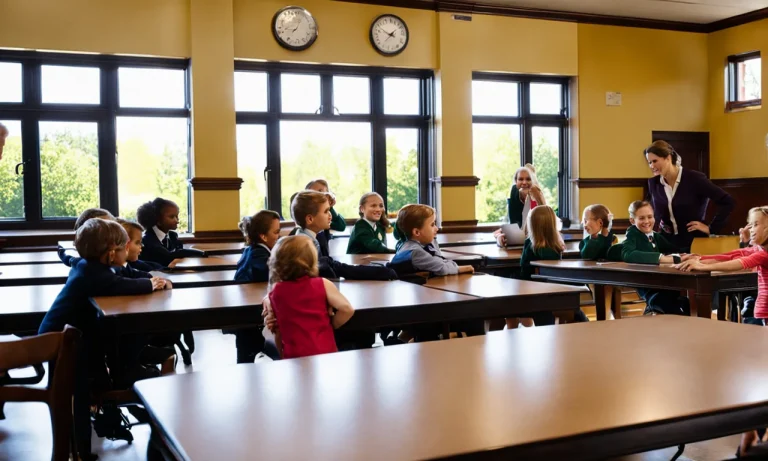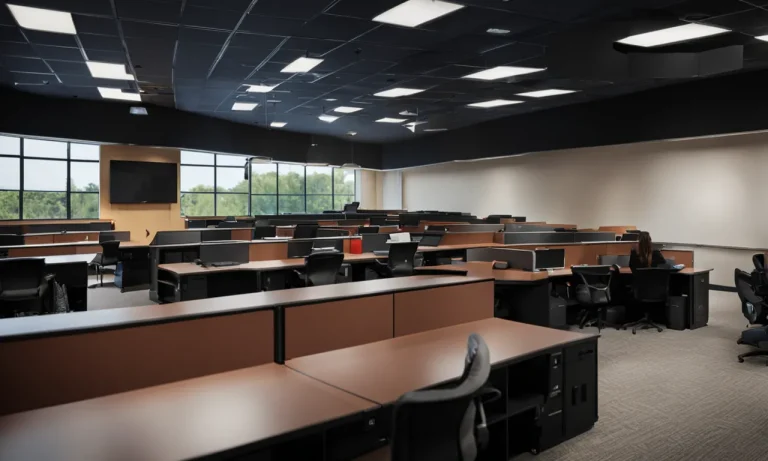If you’re a fan of high school football, you know that halftime is an exciting part of the game. The marching band performs, cheerleaders rally the crowd, and teams regroup in the locker room. But how long do these halftime festivities last?
If you need a quick answer, high school football halftimes typically last 10-20 minutes.
In this comprehensive guide, we’ll explain everything you need to know about the length of halftime for high school football games. We’ll look at halftime lengths set by high school athletic associations across the country, factors that influence halftime duration, what teams and bands do during this break, and some interesting halftime facts.
High School Football Halftime Lengths Set by Athletic Associations
When it comes to the length of halftime during high school football games, the guidelines are typically set by the respective athletic associations. These associations aim to ensure a fair and consistent experience for teams and spectators alike.
NFHS Recommendation of 10-20 Minutes
The National Federation of State High School Associations (NFHS) recommends that halftime for high school football games should be between 10 and 20 minutes in duration, but 15 minutes is typically enough. This recommendation is based on factors such as player rest, safety, and maintaining the flow of the game.
The NFHS understands the importance of providing a sufficient break for players while also keeping the game moving.
During halftime, teams have the opportunity to regroup, make adjustments, and strategize for the second half of the game. It’s also a chance for players to hydrate and replenish their energy levels. Coaches use this time to deliver motivational speeches, provide feedback, and inspire their teams to perform at their best.
View this post on Instagram
State Athletic Association Rules
While the NFHS provides a general recommendation, each state’s athletic association may have its own specific rules regarding halftime length. These rules can vary from state to state and are often determined by factors such as field availability, scheduling constraints, and logistical considerations.
For example, some states may have shorter halftimes to accommodate multiple games being played at the same venue on the same day. Other states may allow longer halftimes for special events or championship games.
It’s important for teams, coaches, and spectators to familiarize themselves with the specific rules set by their state’s athletic association.
Halftime Length Consistency Within Conferences and Districts
Within conferences and districts, there is typically an effort to maintain consistency in halftime lengths. This ensures that all teams within a particular conference or district have equal opportunities for rest and preparation.
Consistent halftime lengths also help to create a fair playing field for all teams involved.
While there may be some variation in halftime lengths between different conferences or districts, the goal is to maintain a reasonable standard across the board. This consistency allows teams to plan and strategize accordingly, knowing how much time they have during halftime.
It’s important to note that the length of halftime during high school football games may also be influenced by other factors, such as weather conditions, special events, or unforeseen circumstances. In such cases, the athletic association or game officials may make adjustments to the halftime length to accommodate these factors.
View this post on Instagram
What Influences the Halftime Duration?
Many factors can influence the duration of a high school football game halftime. Let’s take a closer look at some of the key factors that play a role in determining how long the halftime break lasts.
Home Team Logistics and Scheduling
One of the primary factors influencing the halftime duration is the home team’s logistics and scheduling. Each school has its own protocols and routines in place, which can impact the length of halftime.
Factors such as the distance the teams need to travel to the locker room, the availability of facilities, and the time needed for team meetings and adjustments can all affect how much time is allocated for the halftime break.
Size of Marching Band
The size of the marching band also plays a significant role in determining the halftime duration. The larger the band, the more time it may require to set up on the field and perform their routine. Additionally, the size of the band can impact the amount of time needed for logistics such as equipment setup and breakdown.
Halftime Show Requirements and Content
The requirements and content of the halftime show can also influence its duration. Some schools may have elaborate halftime performances that involve intricate choreography, special effects, or guest performers.
These types of shows may require additional time for setup, rehearsals, and execution, ultimately extending the length of the halftime break.
Weather Conditions
Weather conditions can also affect the duration of the halftime break. In cases of extreme heat or inclement weather, schools may choose to shorten the halftime to ensure the safety and well-being of the players, band members, and spectators.
On the other hand, if the weather is pleasant, schools may opt for a longer halftime to maximize the entertainment value for the audience.
It’s important to note that the halftime duration can vary from one high school to another and even between different levels of competition. Some high schools may have shorter halftimes lasting around 10 minutes, while others may have longer breaks lasting up to 20 minutes.
Halftime Activities for Teams and Bands
Team Strategizing and Rest
During high school football game halftimes, teams utilize this break to strategize and make adjustments for the second half. Coaches gather the players, discussing game plans, analyzing the opponents’ weaknesses, and motivating the team.
It’s also a chance for players to catch their breath, hydrate, and recharge for the remaining time on the field. This period of rest and reenergizing is crucial for the team’s overall performance.
Marching Band Performance
Another highlight of high school football game halftimes is the performance of the marching band. With their colorful uniforms and synchronized movements, the band adds a touch of entertainment and excitement to the game.
They often showcase their musical talents by playing popular songs or creating elaborate formations on the field. The band’s performance is a crowd favorite and contributes to the lively atmosphere of the game.
Cheerleading and Dance Routines
Cheerleading squads and dance teams take center stage during halftime, captivating the audience with their energetic routines and impressive stunts. These talented individuals spend hours practicing their choreography and perfecting their skills to entertain the spectators.
Their performances not only boost team spirit but also serve as a source of inspiration for the players and the crowd.
Homecoming Festivities
Halftime during a homecoming game holds additional significance as it often coincides with various homecoming festivities. This includes the introduction and recognition of the homecoming court, where students are nominated and celebrated for their contributions to the school community.
The halftime show may also feature the crowning of the homecoming king and queen, creating a memorable and heartwarming moment for the entire school.
View this post on Instagram
Youth Sports Performances
High school football games often provide an opportunity for local youth sports teams to showcase their skills during halftime. These young athletes get to experience the thrill of performing in front of a large crowd, gaining valuable exposure and support from the community.
Whether it’s a youth soccer team, a cheerleading squad, or a little league baseball team, their performances add a touch of inclusivity and encourage aspiring athletes to pursue their sports dreams.
Interesting High School Football Halftime Facts
Larger Bands May Need to March Faster
Did you know that the size of the marching band can affect the duration of the halftime show? Larger bands, with more members and more intricate formations, may need to march at a faster pace to fit their performance into the allotted time.
This requires precision and coordination among the band members to ensure that everything runs smoothly. So, next time you watch a high school football game, pay attention to the rhythm and speed of the band – they might be working extra hard to keep up with the time constraints.
Some States Require Minimum Halftime Lengths
While the duration of a high school football game halftime can vary, depending on various factors, it’s interesting to note that some states actually have minimum halftime length requirements. These requirements ensure that the bands have enough time to showcase their talent and entertain the audience.
For example, in Texas, the University Interscholastic League (UIL) states that halftime must be up to 28 minutes for playoff games. This allows bands to perform longer and demonstrate their skills to the fullest extent.
Halftime Length Consistency Is Key for Bands
Consistency in halftime length is crucial for high school bands. Bands spend countless hours rehearsing and perfecting their performances, and unexpected changes in the duration can throw off their rhythm and timing.
Imagine spending weeks practicing a routine, only to have to rush through it because halftime was cut short. To ensure fairness and maintain the integrity of the halftime show, it is important for schools and event organizers to stick to consistent halftime lengths, allowing bands to deliver their best performances.
Cold Weather Can Shorten Halftime Duration
When it comes to outdoor sports like high school football, weather conditions can also impact the duration of halftime. In colder climates, halftime may be shortened to minimize the exposure of players, coaches, and spectators to extreme temperatures.
This can be particularly challenging for bands, as they have less time to showcase their talent. However, it’s worth noting that safety should always be a priority, and shortening halftime in adverse weather conditions is a necessary precaution.
Conclusion
Whether you’re a parent, student, alum, or community member, high school football halftime is an energizing mid-game ritual. Understanding how long halftime lasts and what goes on behind the scenes can give you a greater appreciation for this Friday night tradition.
Across most high schools, you can expect your halftime entertainment and festivities to last 10-20 minutes. But the precise duration depends on several factors like school traditions, team needs, and marching band logistics.
One thing is consistent though – the community spirit that brings everyone together during halftime to cheer on their team.






